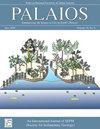元古代潮汐环境中有机-阳离子相互作用的生物特征保存
IF 1.5
4区 地球科学
Q2 GEOLOGY
引用次数: 2
摘要
摘要:元古代有机生物特征的保存需要特定的埋藏有机物的埋藏窗口,以保存无定形干酪根,甚至微生物体化石,然后才能被广泛降解。这种保存的一些最好的例子是在潮缘环境中形成的早成岩燧石中发现的。该燧石包含无定形干酪根的离散区域,有时还包含干酪根微生物席结构和微生物体化石。我们对这些精美的微体化石是如何保存的以及有机降解和矿物形成之间的平衡的理解仍然不完整。在这里,我们通过有机物、阳离子和二氧化硅之间的相互作用,对元古代潮缘环境中的有机保存提出了新的见解。元古界潮缘环境中的有机物并不是由微晶石英或隐晶质石英单独保存的。相反,保存包括含有镁、钙、二氧化硅和铝的富含阳离子的纳米相,这些相早于燧石侵位,可能为二氧化硅沉积提供成核位点,并使燧石得以进一步开发。使用扫描电子显微镜和能量色散X射线光谱的元素图谱,我们确定了元古界有机物中的阳离子富集和早于燧石的富阳离子纳米相。我们将这些分析与沉淀实验相结合,以研究阳离子在海水中二氧化硅沉淀中的作用。我们的研究结果表明,在潮缘环境中进行有机保存需要通过有机物与海水的相互作用快速形成纳米级矿物相。这些有机阳离子相互作用可能为生物特征的保存和埋葬奠定了初步基础,为含化石燧石的开发铺平了道路,该燧石现在包含这些生物特征,并保存了元古代生命的记录。本文章由计算机程序翻译,如有差异,请以英文原文为准。
BIOSIGNATURE PRESERVATION AIDED BY ORGANIC-CATION INTERACTIONS IN PROTEROZOIC TIDAL ENVIRONMENTS
Abstract: The preservation of organic biosignatures during the Proterozoic Eon required specific taphonomic windows that could entomb organic matter to preserve amorphous kerogen and even microbial body fossils before they could be extensively degraded. Some of the best examples of such preservation are found in early diagenetic chert that formed in peritidal environments. This chert contains discrete domains of amorphous kerogen and sometimes kerogenous microbial mat structures and microbial body fossils. Our understanding of how these exquisite microfossils were preserved and the balance between organic degradation and mineral formation has remained incomplete. Here, we present new insights into organic preservation in Proterozoic peritidal environments facilitated through interactions among organic matter, cations, and silica. Organic matter from Proterozoic peritidal environments is not preserved by micro- or cryptocrystalline quartz alone. Rather, preservation includes cation-rich nanoscopic phases containing magnesium, calcium, silica, and aluminum that pre-date chert emplacement and may provide nucleation sites for silica deposition and enable further chert development. Using scanning electron microscopy and elemental mapping with energy dispersive X-ray spectroscopy, we identify cation enrichment in Proterozoic organic matter and cation-rich nanoscopic phases that pre-date chert. We pair these analyses with precipitation experiments to investigate the role of cations in the precipitation of silica from seawater. Our findings suggest that organic preservation in peritidal environments required rapid formation of nanoscopic mineral phases through the interactions of organic matter with seawater. These organic-cation interactions likely laid the initial foundation for the preservation and entombment of biosignatures, paving the way for the development of the fossiliferous chert that now contains these biosignatures and preserves a record of Proterozoic life.
求助全文
通过发布文献求助,成功后即可免费获取论文全文。
去求助
来源期刊

Palaios
地学-地质学
CiteScore
2.80
自引率
12.50%
发文量
40
审稿时长
6 months
期刊介绍:
PALAIOS is a monthly journal, founded in 1986, dedicated to emphasizing the impact of life on Earth''s history as recorded in the paleontological and sedimentological records. PALAIOS disseminates information to an international spectrum of geologists and biologists interested in a broad range of topics, including, but not limited to, biogeochemistry, ichnology, paleoclimatology, paleoecology, paleoceanography, sedimentology, stratigraphy, geomicrobiology, paleobiogeochemistry, and astrobiology.
PALAIOS publishes original papers that emphasize using paleontology to answer important geological and biological questions that further our understanding of Earth history. Accordingly, manuscripts whose subject matter and conclusions have broader geologic implications are much more likely to be selected for publication. Given that the purpose of PALAIOS is to generate enthusiasm for paleontology among a broad spectrum of readers, the editors request the following: titles that generate immediate interest; abstracts that emphasize important conclusions; illustrations of professional caliber used in place of words; and lively, yet scholarly, text.
 求助内容:
求助内容: 应助结果提醒方式:
应助结果提醒方式:


